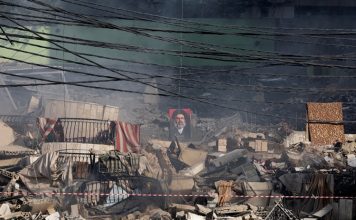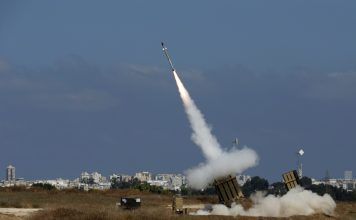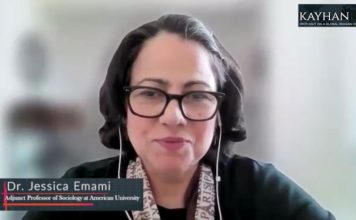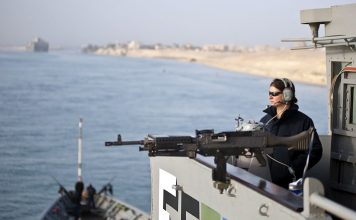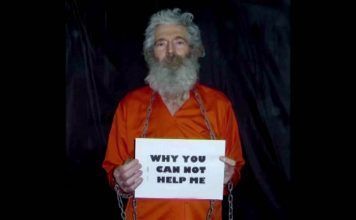Iran’s regime has been actively involved in the Israel-Hamas war since it began on Oct. 7, but there is no evidence to suggest that it helped plan the initial attack, Lieutenant Colonel Jonathan Conricus, the international spokesperson for the Israel Defense Forces (IDF) has said.
Hamas, a militant group based in Gaza, carried out a deadly attack in Israel on Oct. 7 — launching more than 3,000 rockets into Israel, burning down homes, killing more than 1,000 civilians and taking an estimated 215 hostages. The attack, which ignited the war, was later named Operation Al-Aqsa Flood by Hamas and other Palestinian armed groups.
[aesop_image img=”https://kayhanlife.com/wp-content/uploads/2023/11/2023-11-18T000000Z_1510015518_MT1NURPHO000SEM0Y3_RTRMADP_3_ISRAEL-PALESTINIANS-IRAN.jpg” panorama=”off” credit=”An unidentified man wearing a mask and a military uniform performs as a member of the Palestinian group Hamas waves flags during an anti-Israeli rally at Enghelab (Revolution) Square in Tehran, November 18, 2023. REUTERS./” align=”center” lightbox=”on” captionsrc=”custom” captionposition=”left” revealfx=”off” overlay_revealfx=”off”]
The Israeli response to the Oct. 7 attack has left an estimated 13,000 Palestinians dead, including thousands of children, according to a Nov. 20 report by the United Nations in the Palestinian territories.
Between the Islamic Republic and Hamas, there has been “mostly guidance, political directives and planning since Oct. 7,” said Conricus in an interview with Kayhan Life. “High level meetings, operational work-level meetings where Hamas officials, Hezbollah officials, both political and military, are in direct and important operational consultations with the Islamic Revolutionary Guard Corps, and with senior leadership. Some of those meetings have been made official.”
“I think that is very clear proof of direct Iranian involvement in the running of operations, military efforts, diplomatic efforts, hostage relief, and negotiations,” he added.
“I do not have evidence or intel that suggests an Iranian presence on the ground in managing operations. We do not have any indication that Iran-made weapons came into Gaza after Oct. 7, but they all came there either through Iranian money or Iranian efforts,” Conricus said.
Cornicus said the weapons that Hamas used were sophisticated. They included Iran-made drones, thermobaric charges with the ability to burn down houses, and land mines made in Italy; the most advanced weaponry was produced in Russia.
Asked whether Israel had plans to confront the Iranian regime’s other militia groups in the region, Cornicus said: “Yes, there’s contingency planning and there are plans to deal with the other groups. The first order of the day is Hamas in Gaza.”
“We must also find a solution for the challenge to remove Hezbollah from Israeli communities,” he said. “There are various ways of doing that. There’s the diplomatic way, there’s the military way, and out of the military way there’s a few different options,” he added.
Iranian officials have held meetings with Hamas, Lebanese Hezbollah and Islamic Jihad in recent weeks, sparking concerns that the discussions were evidence of Iran’s direct involvement in the planning of the Nov. 7 attack.
NATO Secretary General Jens Stoltenberg said the Islamic Republic in Iran “must rein in its proxies,” during a Nov. 27 speech at a press conference ahead of a meeting with NATO’s ministers of foreign affairs.
“NATO Allies are present in the wider Middle East region,” Stoltenberg said. “We have seen drone and rocket strikes on U.S. positions in Syria and Iraq, as well as attacks on commercial shipping. This underlines the risk of escalation. Iran must rein in its proxies.”
Stoltenberg said NATO was sending a message to “underline the importance that Iran actually doesn’t use this situation to turn this war into a full scale regional conflict.”
Militant groups in the Middle East including Hamas, Palestinian Islamic Jihad and Lebanese Hezbollah are viewed as Iran proxies by the West because of the financial support and training that the Iranian regime provides these organizations.
The groups, which have all been designated terrorist organizations by the US, have carried out dozens of border strikes from countries neighboring Israel since the start of the war. They see themselves as a resistance movement against Israeli and Western influence in the Middle East, which Iran calls its “axis of resistance.”
The armed groups have been called “part of the Iranian axis of terror” by the IDF, which is also known by the Hebrew acronym Tzahal. The accusation was made during a Nov. 25 Q&A session with IDF on the social media platform X, formerly known as Twitter.
“Over the last 49 days we have been engaged by numerous threats on our borders all of which are part of the axis of Iranian terror,” Doron Spielman, an IDF spokesperson, said.
“We are committed to bringing back home all our hostages and we are committed to our other goal, which is really of global importance, which is to completely dismantle Hamas to prevent them from carrying out their ideology and massacring Israelis or people anywhere around the world,” Spielman said.
Cornicus said the IDF had been asked “to provide its professional opinion of the viability and the chances, and its professional recommendation for the war cabinet” on a possible hostage and prisoner exchange during the truce.
Confirming its engagement with the hostage negotiations, the Islamic Republic said it had facilitated a deal to free 10 Thai hostages held by Hamas. Iran’s embassy in Thailand said it provided a list of names to Hamas, after a request to do so by Thailand’s Foreign Ministry, according to a Nov. 25 report by Reuters.
“We have provided lists since the beginning to everyone,” the spokesperson told Reuters. “Different actors would have a different influence on Hamas.”
The war, which follows decades of tension and violence between Israel’s military forces and Palestinians in the occupied West Bank, has lasted more than 53 days.
Children have made up the majority of hostages and prisoners released during the truce period. Some 159 remaining hostages are believed to be held by Hamas, including 18 children — 10 boys and 8 girls — and 43 women.





